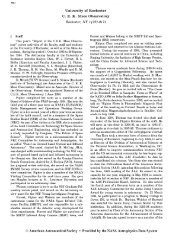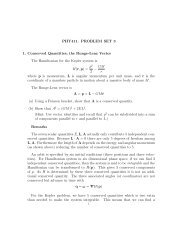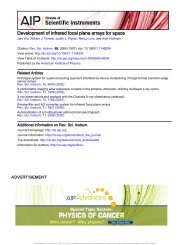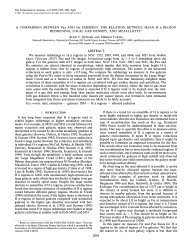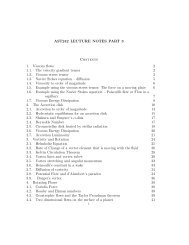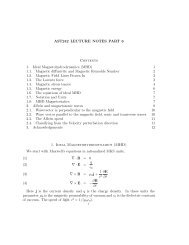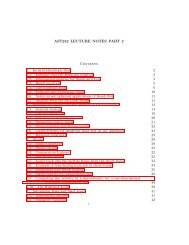AST242 LECTURE NOTES PART 5 Contents 1. Waves and ...
AST242 LECTURE NOTES PART 5 Contents 1. Waves and ...
AST242 LECTURE NOTES PART 5 Contents 1. Waves and ...
- No tags were found...
You also want an ePaper? Increase the reach of your titles
YUMPU automatically turns print PDFs into web optimized ePapers that Google loves.
<strong>AST242</strong> <strong>LECTURE</strong> <strong>NOTES</strong> <strong>PART</strong> 5 15with δ > 0. With our form for the perturbations ∝ exp(i(k · x − ωt) we find that ourperturbations exponentially damp due to thermal conductivity.Note that δ is not small if k is sufficiently large. Hence our assumption that δis small is only satisfied for moderate values of k. For k sufficiently large (or oversufficiently small distances) perturbations are rapidly damped due to conduction.The parameter δ has units of inverse time. We can estimate how much the amplitudeis reduced per wavelength traveled with the factor e −δP where P is the period,P = 2π = 2π .ω c sk4.2. Field Stability Criterion. We consider slow changes or small ω. In this limitω ≪ kc s <strong>and</strong> our dispersion relation (equation 89) reduces to(95)We can rewrite this asiωγ − 1 c2 s + ( Q T − λk 2) T 0p 0c 2 sγ = Q ρ(96) iω = γ − 1 ( )Qρ ρ 0 − Q T T 0 + λk 2 T 0 .γp 0 The ISM is nearly in pressure equilibrium. Since p ∝ ρT we can use ∂ρ ∣∂T p= − ρ T<strong>and</strong>∂Q(97)∂ ln T ∣ = Q T T + Q ρ T ∂ρp∂T ∣ = Q T T − Q ρ ρpThus our dispersion relation (equation 95) becomes[(98) −iω = γ − 1]∂Qγp 0 ∂ ln T ∣ − λk 2 T 0pIn the case of no conductivity (λ = 0) there is instability when(99) instability ⇐⇒ ∂Q∂ ln T ∣ > 0pThis is called the Field stability criterion.Let us consider the Field stability criterion physically. Pressure equilibrium isexpected otherwise there will be large velocities generated <strong>and</strong> mixing. If increasingthe temperature increases the heating rate then the temperature will continue torise <strong>and</strong> we will have instability. If increasing the temperature decreases the heatingrate then we will have convergence to a stable situation. For the second case, givingstability, we have negative feedback. For the first case, giving instability, we havepositive feedback. I note that there can be instability even in the negative feedbackcase if the feedback (heating or cooling) is delayed, a situation that we have not




